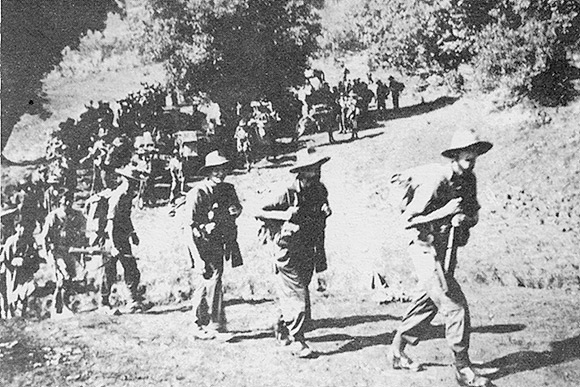Major R R Acheson's Account of 21 Column
Annex G
Major R R Acheson, who was Adjutant of 2 Queen's, writes,
The formation of 21 and 22 Columns

21 Column on the march led by Major E G B Clowes (commanding the column)
16 Brigade was given to General Wingate as part of the Special Force for his second operation in Burma, and Bernard Fergusson became Brigade Commander. The Battalion was re-organised into two Columns, No 21, under Colonel Graham Duncombe our Commanding Officer, and No 22, under the Second in Command, Major Terence Close. I, as Adjutant, went with 21 Column, Edward Clowes was Column 2IC and Chris Phillips the Intelligence Officer. Before the end of 1943, Colonel John Metcalfe came to succeed as CO Graham Duncombe, who went to command 1 Queen’s on the Arakan front. We were all very fond of Graham, but soon liked and respected John.
The march into Burma
We had a few days and nights with torrential rain at Ledo railhead before our 400 miles march into Burma in February 1944. Gradients were sometimes 1 in 1 in the Naga Hills through which we started. The slope was slippery and unstable, and mules had to be unloaded and pulled up. It took us 11 days to cover the first 35 miles.
'Column snake' was single file - 400 men, 60 mules and some ponies. We had to move as silently as possible. Communication within the Column was by walky-talky. The front section used its dahs to cut a way through the entangled undergrowth, and there were numerous delays and detours. At the rear marched Doc Harrison and Padre Pritt to fortify the laggards in body and soul. Each of us carried 701bs or more weight of arms, equipment and food. We all grew beards for camouflage, as well as to save time and water.
Rain was ceaseless for the first few days, but we were soon short of water because we were travelling along a ridge and rainwater fell hundreds of feet down each side to streams we couldn't possibly reach. We were lucky to find a small piece of open ground, just enough "for a drop.
Supply by Air
In the Naga Hills it was very difficult to find clear level spaces for supply drops, which we needed every five days or so. Maps were insufficiently detailed. Inevitably we lost a good many parachute loads stuck up trees or down the hillside, and then we had to make 3 or 4 days supply of rations do for 5 to 7 days. Mails were erratic and very welcome when they came; knowledge that the air drop contained mail meant strenuous efforts to collect all the drop.

Recovering supplies from the Air Drop
We lived for the first five weeks solely on the American K ration, designed for emergency use. It was mess tin cooking all the time, except occasionally at 'Aberdeen', when we had the luxury of meat. We marked dropping grounds by fires - flame by night, smoke by day, but we each carried for this purpose, if needed, a map of Burma on a 26 inch square brilliant orange silk handkerchief, which could be seen from the air high up.
By 1944 we had only three officers and a few Other Ranks who were Regular soldiers, but the best traditions of a Regular battalion had survived. Relationships among all ranks were excellent, and morale was very good. We had some tough times together in Burma before we marched to 'Broadway' to be flown out in May, but spirits remained high. In June we moved to Southern India again. We embarked for home towards the end of January 1945.
Related
